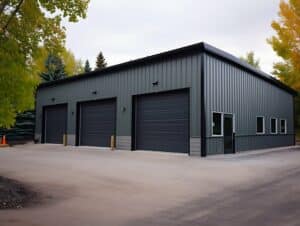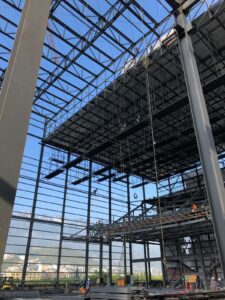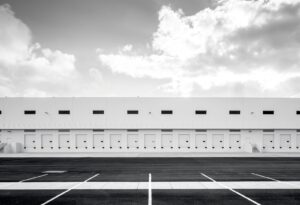Insulating steel buildings and knowing the insulation types available is a an important step in building construction and maintenance process.
The insulation industry, including the manufacture, distribution, and installation of insulation, supports over 550,000 jobs and generates nearly $36 billion in payrolls. Insulation materials manufacturing is a $17.8 billion business, directly employing more than 39,000 people across 45 states.
With proper insulation, steel buildings can enjoy enhanced energy efficiency and structural integrity.
Additionally, the choice of insulation materials and strategies should be based on various factors such as climate, building size, and fire safety considerations.
In this article, we will explore the importance of insulation in steel buildings, the different types of insulation available, key factors to consider, and provide a step-by-step guide to help you effectively insulate your steel building.
Table of Contents:
- Understanding the Importance of Insulation in Steel Buildings
- Different Types of Insulation Suitable for Steel Buildings
- Key Factors to Consider When Insulating Steel Buildings
- Step-by-Step Guide to Insulating Steel Buildings
- Conclusion
- Frequently Asked Questions
Understanding the Importance of Insulation in Steel Buildings
The role of insulation in steel buildings is two-fold. Firstly, insulation plays a significant role in improving energy efficiency. By effectively preventing heat transfer, insulation helps to maintain a comfortable indoor temperature, reduces heating and cooling costs, and minimizes the overall energy consumption of the building.
Secondly, insulation contributes to the structural integrity of steel buildings. Steel is a highly conductive material that is prone to condensation. Without proper insulation, the temperature fluctuations can cause moisture buildup and potential damage to the building’s structure over time.
Insulation acts as a barrier, preventing condensation and protecting the steel framework. Moreover, insulation in steel buildings also aids in soundproofing. Steel structures can sometimes resonate with sound, leading to echoes and noise disturbances. Insulation materials with sound-absorbing properties can help dampen noise levels, creating a more peaceful and productive indoor environment.
This is particularly important in industrial or commercial steel buildings where machinery noise or high-traffic areas can be disruptive.
Additionally, proper insulation can enhance fire resistance in steel buildings. Certain types of insulation materials are designed to be fire retardant, providing an extra layer of protection in case of a fire emergency.
By slowing down the spread of flames and reducing the intensity of heat transfer, insulated steel buildings can improve overall safety measures and potentially save lives.
Check out: Cooling Solutions For Metal Buildings
Different Types of Insulation Suitable for Steel Buildings
Batt and Blanket Insulation
Batt and blanket insulation are commonly used in steel buildings due to their affordability and ease of installation. They consist of flexible rolls or batts made from materials such as fiberglass or mineral wool.
This type of insulation is suitable for walls and roofs, providing excellent thermal resistance and soundproofing.
One of the key advantages of batt and blanket insulation is its versatility. It can be easily cut to fit around obstacles such as beams or electrical wiring, ensuring a snug and effective insulation barrier.
Additionally, batt and blanket insulation are known for their fire-resistant properties, adding an extra layer of safety to steel buildings.
Spray Foam Insulation
Spray foam insulation is a popular choice for insulating steel buildings as it offers superior thermal resistance and air-sealing properties. It is sprayed onto the walls and expands to fill gaps, creating a seamless layer of insulation. Spray foam insulation also helps to strengthen the structure by adhering to the steel framework.
Another benefit of spray foam insulation is its ability to provide a moisture barrier, preventing condensation and mold growth within the building. This can be particularly advantageous in steel structures where moisture control is essential to maintain the integrity of the building materials over time.
Rigid Board Insulation
Rigid board insulation is a durable and efficient option for steel buildings. Made from materials such as polyisocyanurate or extruded polystyrene, this insulation type provides high thermal resistance and moisture resistance. Rigid board insulation is commonly used for roofs and walls.
One of the standout features of rigid board insulation is its long-term performance. Unlike some other insulation types, rigid boards maintain their shape and structural integrity over time, ensuring consistent insulation levels throughout the lifespan of the steel building.
Additionally, rigid board insulation is resistant to pests and does not provide a food source for insects or rodents, further enhancing its durability.
Key Factors to Consider When Insulating Steel Buildings
When it comes to insulating steel buildings, several key factors need to be taken into consideration to ensure optimal energy efficiency and comfort.
In addition to climate and weather conditions, building size, design, and fire safety considerations play crucial roles in determining the most suitable insulation solutions.
Climate and Weather Conditions
The climate and weather conditions in your area play a crucial role in determining the insulation needs of your steel building. Colder climates may require higher insulation levels to prevent heat loss, while hotter climates may require insulation that can manage heat gain.
Factors such as humidity levels and seasonal temperature variations should also be considered when selecting insulation materials.
Building Size and Design
The size and design of the steel building also impact the insulation requirements. Larger buildings may have different insulation needs compared to smaller structures. The building design, including the number of openings and windows, should also be considered when selecting insulation materials and installing them.
Proper insulation not only helps in maintaining a comfortable indoor temperature but also contributes to the overall structural integrity of the building.
Fire Safety Considerations
Fire safety is of utmost importance when insulating steel buildings. Insulation materials with fire-resistant properties should be chosen to reduce the risk of fire spread.
Additionally, proper installation techniques and compliance with fire safety regulations are essential to ensure the safety of the building and its occupants.
It is crucial to select insulation materials that have been tested and certified for their fire performance to provide maximum protection in case of a fire emergency.
Step-by-Step Guide to Insulating Steel Buildings
Preparing the Building for Insulation
Before starting the insulation process, ensure that the building is clean and free from debris. Any existing insulation that is damaged or insufficient should be removed. Inspect the building for any air leaks or gaps that may need to be sealed before insulation installation.
Additionally, it is recommended to check the structural integrity of the steel building before proceeding with insulation. Look for signs of corrosion, rust, or damage that may compromise the effectiveness of the insulation.
Addressing any structural issues beforehand will ensure a more secure and long-lasting insulation solution.
Pro tip:
Remember that even the highest R-value insulation may not work effectively if air leaks through gaps and cracks in your building envelope. Air infiltration and exfiltration can significantly reduce the performance of your insulation, leading to increased energy costs, discomfort, and potential moisture problems. Use caulk for small gaps and expanding spray foam for larger areas. This will help prevent warm air from escaping in the winter and hot air from entering in the summer, maximizing the efficiency of your insulation.
Installing the Insulation
Install the chosen insulation material according to the manufacturer’s instructions. For batt and blanket insulation, roll out the material and secure it in place using staples or adhesive. When using spray foam insulation, follow the recommended application techniques and ensure even coverage.
Rigid board insulation can be cut to size and attached to the walls or roof using appropriate fasteners.
Furthermore, consider the climate and weather conditions of the steel building’s location when selecting the insulation material.
Different insulation types offer varying levels of thermal resistance, moisture control, and durability. Choosing the right insulation based on these factors will optimize energy efficiency and comfort within the building.
Checking the Insulation for Potential Issues
After installation, it is crucial to inspect the insulation for any potential issues. Look for gaps or areas where insulation may have been missed. Check for proper sealing around openings, windows, and joints. Address any identified issues promptly to ensure the insulation performs efficiently.
Moreover, conducting regular maintenance checks on the insulation system is essential for its longevity and performance. Monitor for any signs of wear and tear, pest infestation, or water damage that could compromise the insulation’s effectiveness.
By staying proactive in upkeep, you can prolong the lifespan of the insulation and maintain a well-insulated steel building.

Conclusion
Effective strategies for insulating steel buildings involve understanding the importance of insulation in terms of energy efficiency and structural integrity. Considering factors such as climate, building size, and fire safety is essential when selecting the right insulation materials.
Following a step-by-step guide to preparing the building, installing the insulation, and checking for any potential issues ensures a well-insulated steel building that offers improved energy efficiency and longevity.
SteelCo has 23+ years of experience dropshipping customizable steel building materials and kits for commercial, retail, and mixed-use buildings, across the US.
As a locally awarded General Contractor, our expertise also extends to comprehensive commercial design-build and construction projects across Georgia. Learn more about our services.
——————-
Frequently Asked Questions
Can I install insulation myself, or should I hire a professional?
Whether to install insulation yourself or hire a professional depends on your DIY skills, the complexity of the job, and the insulation type. DIY can save costs and offer flexibility, but requires a certain level of expertise. Professional installation, while more costly, provides expert handling, time efficiency, and quality assurance with warranties. For simple projects and those confident in their abilities, DIY may be suitable, but for complex installations or if in doubt, it’s advisable to engage a professional for optimal results.
Are there any building codes or regulations that I need to be aware of when insulating a steel building?
Yes, there are specific building codes and regulations that you need to be aware of when insulating a steel building. These codes are designed to ensure safety, structural integrity, and energy efficiency. Tools like the U.S. Department of Energy’s COMcheck can assist in verifying compliance with these codes.
What is the cost of insulating a steel building?
The installation cost alone can range from $125.00 to $265.00 per square foot. Including materials, the total cost can range from $165.00 to $340.00 per square foot.
What types of insulation are available for steel buildings?
Steel buildings can be insulated with materials like fiberglass, spray foam, double-bubble, reflective insulation, or rigid board insulation. Each type has its own benefits and is suitable for different climates and uses1.
What is the best R-value for metal building insulation?
The best R-value depends on your specific climate and building needs. In very cold or hot climates, higher R-values are recommended, especially if the building is consistently lived in or climate-controlled1.
—————————————-
Check out these related topics:
> Exploring The Key Components Of Steel Buildings
























